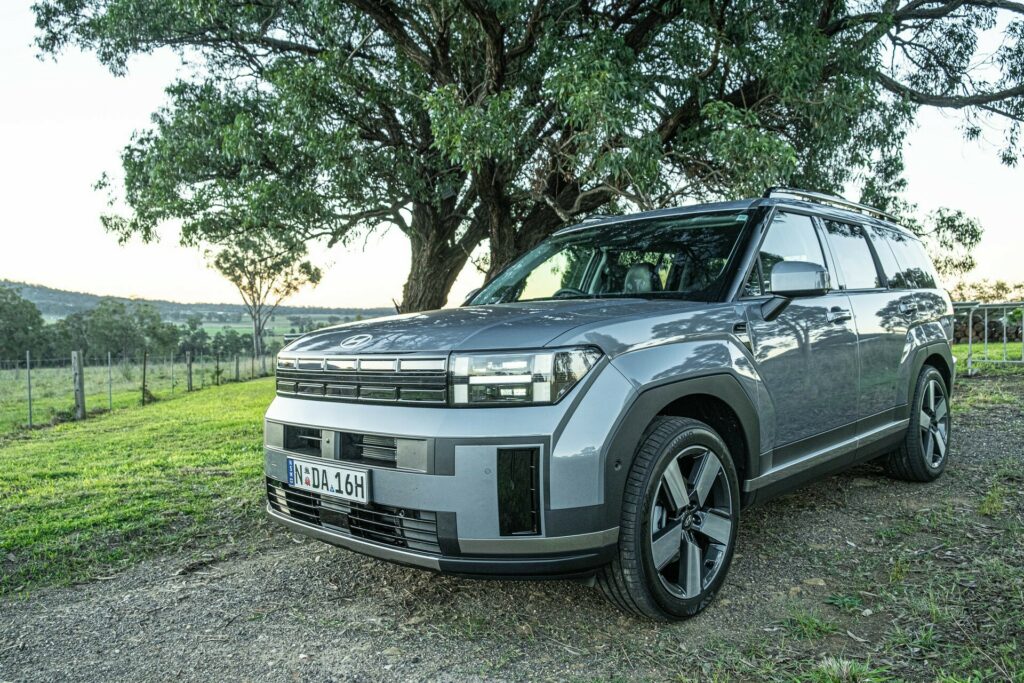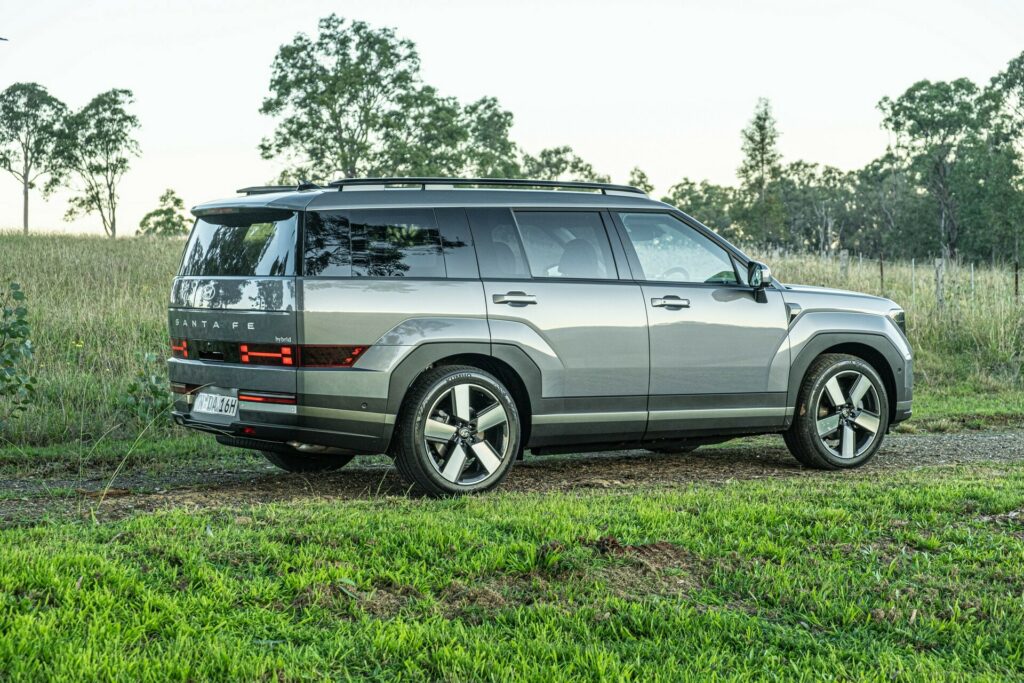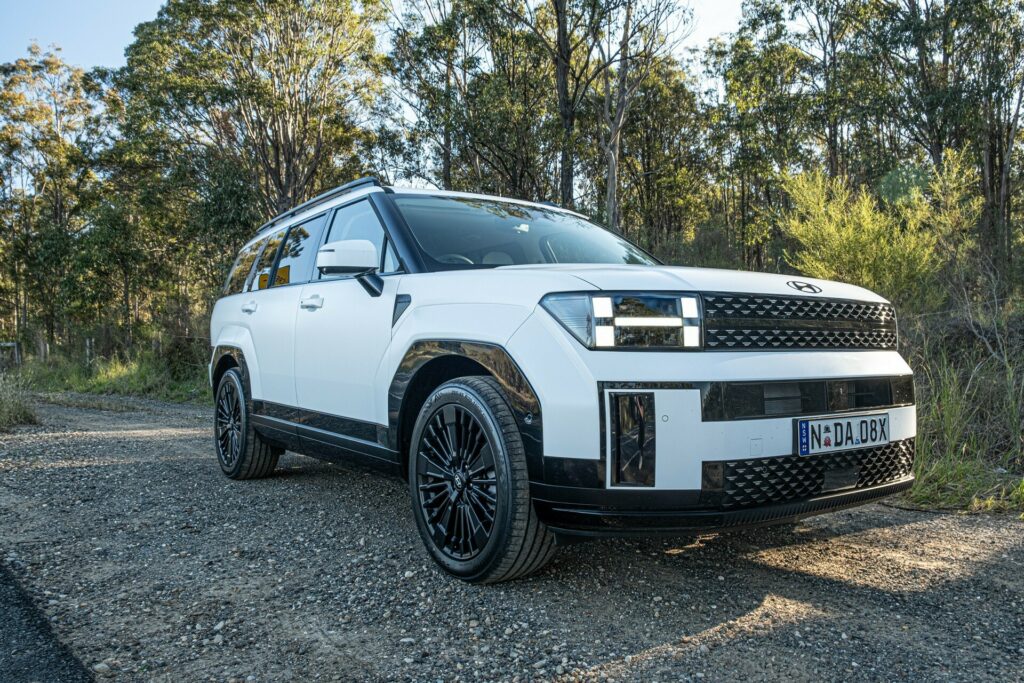The ever-popular Hyundai Santa Fe has entered its fifth generation and while all previous models shared some similarities, the carmaker has thrown out the rule book with the new Santa Fe. It looks nothing like its predecessors, the interior has been overhauled, and it now features a new 1.6-liter hybrid engine.
When Hyundai first showcased the new Santa Fe in July last year, the dramatic exterior design triggered fierce debate among the car community. Some love it, some hate it, but regardless of how you feel about it, there’s an undeniable fact about the Santa Fe we discovered during its recent Australia launch. It’s a seriously good SUV.
So, what makes it so good?
Quick Facts
The 2025 Santa Fe has entered the Australian market with three trim levels and a single hybrid setup. This powertrain consists of a 1.6-liter turbocharged petrol engine working alongside an electric motor mounted in the gearbox and a small 1.49 kWh lithium-ion polymer battery pack. The engine itself is good for 172 kW (231 hp) at 5,600 rpm and 367 Nm (271 lb-ft) between 1,000 rpm and 4,100 rpm while the electric motor adds 44.2 kW (59 hp) and 264 Nm (195 lb-ft) at 1,700 rpm.
While this is the only powertrain on offer during launch, Hyundai will add a 2.5-liter turbocharged petrol engine in Q4. It will pump out 206 kW (276 hp) and 422 Nm (311 lb-ft) of torque and be coupled to an 8-speed dual-clutch automatic transmission. Unfortunately, the carmaker has ditched the 2.2-liter CRDi diesel found in the old Santa Fe and still offered in the facelifted Kia Sorento, citing low sales as the reason. Hyundai also told us that towing isn’t a priority for Santa Fe buyers, meaning most won’t need the added towing capacity a diesel traditionally provides.
Hyundai expects 60% of the 2025 Santa Fe sales to be for the HEV and the rest for the 2.5-liter.
Hyundai Santa Fe Elite
The new Santa Fe is bigger than the model it replaces. It measures 4,830 mm (190.1 inches) in length, is 1,900 mm (74.8 inches) wide, and stands at 1,720 mm (67.7 inches) tall with a 2,815 mm (110.8 inches) wheelbase. That makes it 45 mm (1.7 inches) longer than the old model, 60 mm (2.3 inches) taller, and gives it a 50 mm (1.9-inch) longer wheelbase. When viewed in person, however, the size discrepancy between this new Santa Fe and the old model seems more apparent, partly because of the boxier and more upright design.
Australian buyers can order the new Santa Fe in one of ten available colors, including Creamy White matte and Earthy Brass matte.
Sitting at the base of the range is the standard Santa Fe, available in front-wheel drive and all-wheel drive guises. Positioned above is the Elite, sold exclusively in all-wheel drive, while topping out the range is the Calligraphy, available in six- or seven-seat forms. Hyundai Australia believes roughly 50% of buyers will go for the Calligraphy and expects the Elite and base model to account for 25% of sales each. Prices start at AU$55,500 (~$36,900) for the base model with front-wheel drive and increase to AU$58,500 (~$38,900) with all-wheel drive. The Elite is priced from AU$65,000 (~$43,300) while the Calligraphy tops out at AU$75,000 (~$49,900).
Hyundai Santa Fe Calligraphy
A much-improved interior
The interior of the new Santa Fe shares almost nothing in common with the model it replaces. While we always liked the interior of the fourth-gen model, this new one feels significantly more spacious and premium.
Stepping inside the new Santa Fe for the first time, it’s impossible not to notice the Range Rover-inspired steering wheel. This wheel is similar to the one found in the Hyundai Grandeur in Korea and fittingly reflects the big, chunky nature of the new model. In front of the wheel are dual 12.3-inch screens housed within a single Panoramic Curved Display. Wireless Android Auto and Apple CarPlay come standard. Over-the-air updates are available, and software related to safety systems, braking, performance, and driver assist functions can be updated without visiting the dealer.
Read: 2024 Hyundai Santa Fe Gets A Huge Price Hike To Start At $33,950
At the SUV’s launch, we spent plenty of time in the base model and the flagship Calligraphy and we were deeply impressed with both. The base model, despite starting at a competitive AU$55,500 (~$36,900), is very well equipped. It has the same screens as the flagship model, including a dedicated display for the climate control, and includes a single wireless smartphone charging pad.
Hyundai Santa Fe Calligraphy
A key change made to the fifth-gen Santa Fe is the relocation of the gear selector from the tunnel to the steering column and the adoption of shift-by-wire. This hasn’t just allowed the brand to fit a new storage tray where the old shifter was, but there’s also a large storage cubby beneath the tunnel, a feature we’re more used to seeing in EVs. The standard model’s seats are clad in a lovely soft fabric.
Of course, the Santa Fe Calligraphy’s cabin feels even more special. In fact, it feels almost as premium as the Genesis GV80 we drove a few weeks ago, an impressive feat considering it costs roughly AU$60,000 ($40,000) less.
The steering wheel, dashboard, door panels, center console, and seats of the Calligraphy are adorned in beautiful, soft leather available in several colors. It also adds a configurable ambient lighting system and has a clever storage cubby at the top of the dash, which uses UV-C light to sterilize items like phones, wallets, and glasses. The Elite and Calligraphy also include twin wireless smartphone charges. There’s also a heated steering wheel and heated and ventilated front seats.
Hyundai Santa Fe Calligraphy
Photos: Brad Anderson/Carscoops
Hyundai has fitted a 12-speaker Bose audio system to the Elite and Calligraphy models, and it sounds fantastic. The Calligraphy also adds a digital rear-view mirror and 14-way driver’s and 8-way passenger seats.
The second row is extremely spacious, particularly with the available captain’s chairs. There is plenty of leg room, toe room, and headroom. The lack of a dedicated climate control unit for the second row is a strange omission. Instead, the driver has to use the screen up front to adjust the A/C and heating settings in the second row. The third row is surprisingly spacious, thanks in no small part to the tall roof line, and is big enough for adults.
Cargo space has grown for the new Santa Fe. With the rear seats in position, it offers 628 liters (22.1 cubic feet) of cargo carrying capacity, a figure that increases to 1,949 liters (68.8 cubic feet) with the rear seats folded down.
Photos: Brad Anderson/Carscoops
Smoooootthhhh operator
For most of the first day driving the 2025 Santa Fe, we were in the entry-level model. As mentioned, it starts at AU$55,500 (~$36,900), which is AU$7,500 (~$5,000) more than the base Santa Re we reviewed three years ago. While that’s a sizeable sum, this new Santa Fe feels vastly more premium and is much nicer to drive.
For starters, the interior is way more well-equipped and almost entirely void of the scratchy black plastic of the old model. It doesn’t feel like a step forward but rather a monumental leap. There’s plenty of soft leather and heaps of storage, and the two screens are easy to use and offer crystal-clear graphics. The added space of the new Santa Fe is also impossible to ignore.
While Hyundai’s decision to equip the new Santa Fe as standard with a hybrid powertrain has caused some controversy, it only took us a short time to be won over. The system will intelligently switch between pure electric power and hybrid mode when it sees fit. The SUV has excellent noise insulation, so much so that even when the 1.6-liter engine was on, I couldn’t hear a thing unless giving it a bootful.

The Santa Fe HEV isn’t particularly quick, but it gets up to the speed limit effortlessly and without fuss. The transmission is also supremely smooth. Hyundai quotes fuel consumption of 5.6 l/100 km (42 U.S. mpg) over the combined cycle, and while we didn’t quite match that number, we were able to easily dip into the 6 l/100 km (39.2 U.S. mpg) range for long driving stints.
Read: Next Hyundai Palisade Will Be As Radical As The New Santa Fe
In recent years, Hyundai Australia has prided itself on developing its own suspension tunes to suit local roads. The new Santa Fe does not benefit from a local ride and suspension tune because, according to Hyundai, the company’s Korean engineers considered Australian conditions when developing the SUV. Two prototypes were sent to Australia for testing and both received the thumbs-up from local representatives without needing any chassis tuning. We can see why. This thing is comfortable. Like, really comfortable.
Our route out of Sydney included a mix of highway driving, mountainous roads, and gravel sections, the Santa Fe felt at home in all of them. It is well-damped yet doesn’t feel floaty and still feels agile enough to flick through corners. The front-wheel drive setup of our base model was also more than adequate for everyday driving duties.

Unfortunately, we didn’t get the chance to sample the mid-range Elite, but we did drive the flagship Calligraphy, which will account for the most sales.
In addition to receiving a more well-equipped interior, the Calligraphy sits on distinctive 20-inch wheels, comes with a dual sunroof, and like the Elite, includes more safety features. These include Highway Driving Assist 2 with an automatic lane change function, Navigation-based Smart Cruise Control, and Remote Smart Park Assist. There’s even a handy grab handle on the C-pillar to make it easier to access the roof rails.
The Nappa leather seats are extraordinarily comfortable and only lack a massage function for that authentic luxury feel. The all-wheel drive seamlessly shuffles power between the front and rear wheels. While we drove the Calligraphy on gravel, we could not test the various ‘Terrain’ driving modes. That will have to wait until we can live with it for a week. We also couldn’t test out the towing. Hyundai says it can pull 1,650 kg (3,637 lbs).

Final thoughts
I’ll admit to being a little put off by the new Santa Fe based purely on the images released of it last year. However, get it in the right spec (like the matte white Calligraphy seen here), and it actually looks pretty cool.
Then there’s the cabin. It is a vast improvement over the old model and feels much nicer than the current Kia Sorento. The materials are high-quality, the surfaces are plush, and there’s more than enough technology and safety gear. Add a supremely comfortable drive, and you get a compact SUV that’s hard to ignore. It deserves to be at the top of the shopping list for buyers in this segment.

